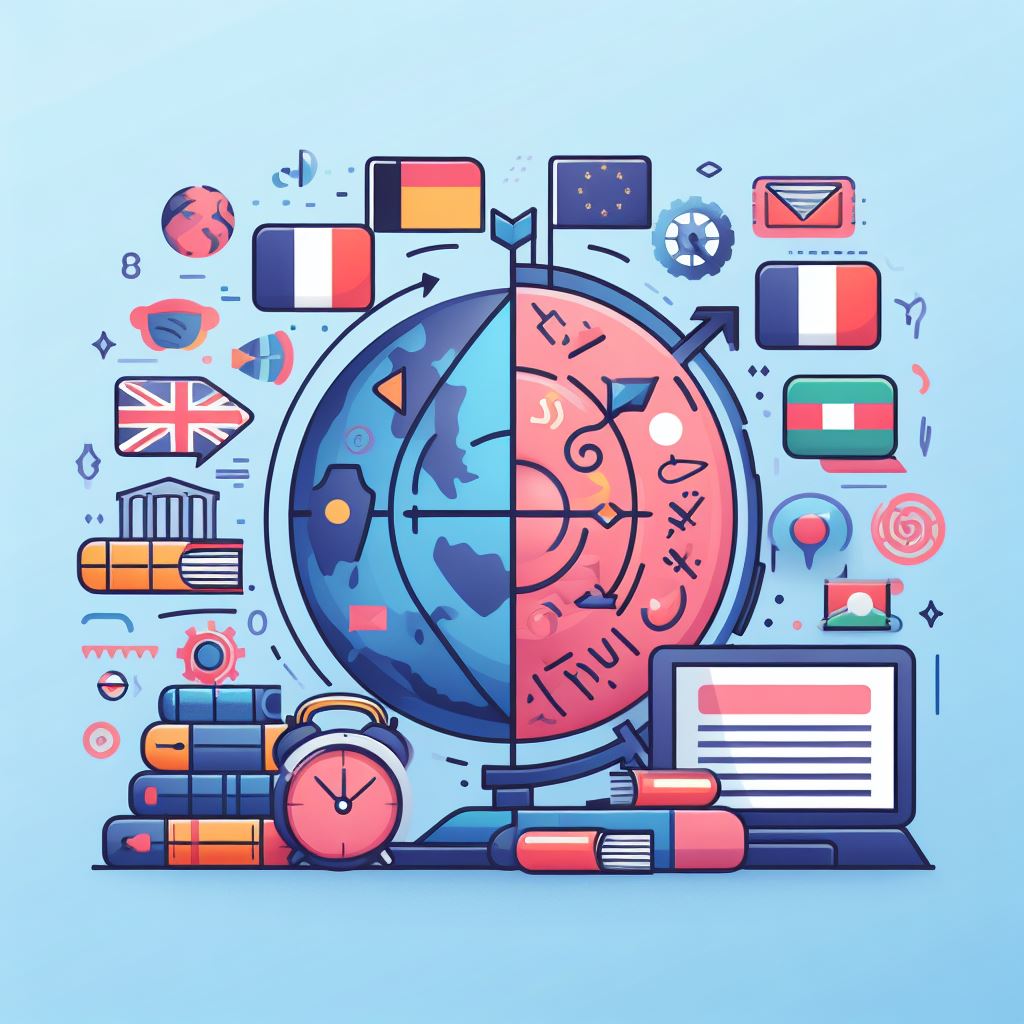
Introduction
In today's interconnected world, writing articles in multiple languages and localisation of content can open up a world of possibilities. It's like having access to countless opportunities, each leading to a wealth of unique cultures, traditions, and communities. And as you venture into these different territories, you'll discover a wide range of untapped readers eagerly waiting to connect with your translated content.
So why limit yourself to just one language? Why not share your voice with people around the globe? By writing articles in multiple languages, you're not only crossing borders; you're also breaking down language barriers and forging meaningful connections.
But here's the thing - venturing into the realm of multilingual writing or web content translation can be daunting. There's more to it than simply translating words word-for-word; it involves capturing the essence, context, and cultural nuances of each language. This process is often referred to as translation localization.
The Benefits of Writing Articles in Different Languages
Writing and localizing articles in multiple languages has several advantages:
- Expanded Reach: By reaching out to readers who speak different languages, you can grow your audience and increase your online presence.
- Enhanced Engagement: When you communicate with people in their native language through article translation, it creates a stronger connection and resonates with them on a deeper level.
- Cultural Sensitivity: Understanding and adapting to the cultural norms and preferences of different regions shows respect and helps you avoid any unintentional misunderstandings through effective content translation.
- Global Perspective: By immersing yourself in different languages and cultures, you gain a broader worldview and develop a more inclusive mindset. This is where the concept of web page localization comes into play.
Key Takeaways:
- Understanding your target audience, their language preferences, and cultural nuances are fundamental to effective multilingual content creation.
- The choice of languages for your content should be dictated by market demand, the potential of the target audience, and regional dialects or variations.
- Embrace AI-powered multilingual translation tools for efficient and accurate content creation in different languages.
- Multilingual SEO is crucial to reach a wider audience and optimize your online presence across different regions.
- Streamlining the management of multilingual content can be achieved through a well-planned content workflow, enhanced collaboration and communication in content translation, and mastering multilingual content management strategies.
1. Understanding the Target Audience

Before we explore multilingual content creation and content localization, let's first understand our target audience. Who are they? What languages do they speak? What are their cultural nuances?
Research and Analysis
In today's digital age, understanding your audience isn't just a good practice—it's a necessity! The first step in this process is thorough research and analysis. Here's what you can do:
- Engage with your audience on social media.
- Conduct surveys.
- Analyze website statistics.
- Use other data collection methods to gather information about your audience.
By doing this, you'll be able to piece together a clear picture of your audience, including their:
- Demographics
- Language preferences
- Likes and dislikes
Language Preferences and Cultural Nuances
Once you have a grasp on who your audience is, it's time to focus on their language preferences and cultural nuances. This is where things can get tricky. It’s not enough to know what language they speak; you must also understand the dialects, slangs, idioms used in that language.
For instance:
- Spanish spoken in Spain is different from that spoken in Latin America.
- Similarly, British English differs from American or Australian English.
It’s important to navigate these subtle differences to truly connect with each segment of your audience during the process of article translation.
Cultural nuances play an equally important role in content translation. Remember, translation isn’t just about words—it’s about conveying meaning. Be aware of cultural symbols, traditions, humor styles that resonate with the target culture.
What may be acceptable in one culture could be offensive in another!
Adaptation is Key
The final step in creating multilingual content is adapting it to connect with various audiences. This involves more than just translating words—it means reimagining ideas so they make sense to people from different cultures.
What Does Adapting Content Involve?
When it comes to adapting content, it's not just about language. It also includes:
- Images
- Colors
- Symbols used in your content that resonate with the target culture
This adaptation process is often referred to as translation localization or web page localization.
The Power of Adaptation
For example, the color red has different meanings in different cultures. In many societies, it represents danger or caution. However, in certain Asian cultures, it is associated with luck and prosperity.
Remember, a well-adapted piece of content can have a strong impact, making your brand relatable across various cultures and languages.
Understanding Your Target Audience: A Puzzle
To truly excel at multilingual content creation and effective localisation of content, you need to understand your target audience like solving a puzzle. Each piece—whether it's language preference, cultural nuance, or adaptation strategy—plays an important role. When these pieces come together, they form a compelling picture that deeply resonates with your audience. And that's when you truly master the art of multilingual content creation!
2. Choosing the Right Languages

With a clear understanding of your target audience, the next step is content localization. This process isn't just about translating your content into numerous languages; it's about choosing the right ones based on strategic considerations.
Market Research on Language Demand
The world is full of languages, each with its own unique sound and appeal. But when it comes to business, not all languages are equally important. This is where market research comes in. Finding out which languages are in high demand within your target market can give your content translation strategy a big boost.
For example, if you're targeting Europe, you might want to consider localising your articles into French, German, Spanish or Italian as these are widely spoken languages across the continent. Similarly, for markets like India or Africa with a wide range of local languages, careful research would be essential for successful article translation.
Prioritising Languages Based on Target Audience and Market Potential
Deciding which languages to focus on can seem overwhelming for businesses wanting to expand into international markets. But don't worry! Here's where knowing your audience pays off in terms of content translation.
- Analyze Demographic Data: Look at information about the people you want to reach to see which language groups make up a significant portion of your target audience.
- Consider Market Potential: Take into account factors such as the purchasing power of these groups, their online behaviour, and their openness to foreign brands.
- Find Overlapping Languages: Identify any languages that are both popular among your target audience and have potential for growth in terms of market size or customer demand.
Remember - it's not just about reaching more people through web content translation; it's about reaching the right people.
Taking Regional Dialects and Variations into Account
When expanding our reach globally, it's important to remember how local differences can impact the way people communicate. Even within the same language group, dialects and regional variations can have a significant influence on meanings. The term for this is web page localization.
For instance, although English is widely spoken around the world, American English and British English have notable differences in vocabulary and spelling. Similarly, Spanish varies across different regions in Spain and Latin America. Recognizing these distinctions can make your articles more relatable to local readers.
Why Regional Differences Matter in Translation Localization
Crafting a successful multilingual content strategy is a delicate balance of several factors:
- Language demand: Researching which languages are most commonly used by your target audience.
- Audience preferences: Understanding what type of content appeals to your audience and tailoring it accordingly.
- Regional variations: Considering the specific dialects or variations within a language that are prevalent in your target regions.
By taking all these aspects into consideration, you can create content that truly resonates with your global audience through effective localisation of content.
3. Creating Content in Different Languages

Crafting content that resonates with a diverse audience involves more than just translating words; it's about bridging cultures, localizing content and connecting with people on a personal level. This process becomes even more complex when content localization or web content translation comes into play, as the content must be presented in various languages. But don't worry! With the right approach and understanding of article translation, you can create engaging multilingual content that will captivate your audience.
Embracing AI-Powered Multilingual Translation
Gone are the days when traditional translation methods were the only option for creating content in different languages. These methods often fell short in capturing the nuances and cultural context required to truly resonate with global audiences. Thankfully, with the advent of AI-powered translation tools like Junia AI's Multilingual AI Translation Tool, a new era of content creation has emerged.
The Power of AI in Multilingual Content Creation
Instead of writing content in one language and painstakingly translating it into multiple languages, businesses can now leverage the power of AI article writers to streamline the process. This allows for efficient content translation across multiple platforms.
How Multilingual AI Translation Tool Works
With a Multilingual AI Translation Tool, you can localize your web page or any other form of content:
- Write your content in one language
- Effortlessly translate it into a variety of other languages
This is an efficient way of handling web page localization and other forms of translation localization.
The Benefits of AI-Powered Translation
Using AI-powered translation offers several advantages:
- Cost and Time Efficiency: By eliminating the need for professional translators or expensive translation services, businesses can significantly reduce their expenses and speed up the content creation process.
- Enhanced Accuracy: While online tools may lack the ability to fully understand context and cultural subtleties, they still provide a more efficient and cost-effective solution for basic translations.
- Contextual Relevance: The tool takes into consideration language structures and cultural interpretations, avoiding direct word-for-word translations that may result in loss of meaning. This helps to preserve the essence of your original message while making it accessible to a global audience.
- No more translating content one by one: With a multilingual AI translation tool, you can now say goodbye to the tedious task of translating content individually. By writing your content in one language and effortlessly translating it into multiple other languages, you can save time, reduce costs, and reach a larger audience with ease. The tool's ability to understand context and cultural nuances ensures that your message remains relevant and meaningful across different languages.
The Role of Human Oversight
It's important to note that even with AI assistance, human oversight in the form of proofreading is necessary to ensure the quality of translated content. Collaborating with others and seeking fresh perspectives can greatly enhance the overall quality of your work.
Traditional translation methods are no longer the preferred choice when it comes to creating content in different languages. Embracing AI-powered translation not only saves time and resources but also allows for accurate and contextually relevant translations. With Junia AI's Multilingual AI Translation Tool, businesses can effortlessly connect with diverse audiences through effective localisation of content, bridging cultures and establishing meaningful connections on a global scale.
4. Optimizing SEO for Multilingual Content

Writing articles in different languages is a powerful strategy, but to make the most of it, you need to optimize your content for search engines in each language. This process of article translation and content localization is known as multilingual SEO.
Why Multilingual SEO Matters
Multilingual SEO is not just about translating your keywords word-for-word. It's about understanding what your target audience in each region is actually looking for. That's why conducting keyword research in different languages is so important.
How to Optimize Your Multilingual Content
Optimizing your multilingual content through content translation and localisation of content is crucial for improving search engine visibility across different markets. Here's a step-by-step guide to help you get started:
1. Conduct Keyword Research
Start by researching keywords in your original language, and then translate them into the target languages using a reliable web content translation tool like Junia AI's AI translation tool. But remember, it's not just about the translation—it's about finding the right words that resonate with your audience in each market.
Consider using an international keyword research tool to check the popularity and competitiveness of these keywords in the target markets. Adjust your keywords as necessary based on your findings.
2. Adapt Your SEO Strategy for Each Market
After identifying your target keywords, it's time to adapt your overall SEO strategy for each market. Here are some factors to consider:
- Content Type: Different types of content may perform better in different markets. For example, blog posts may be popular in one market, while videos may be more effective in another. Tailor your content strategy accordingly.
- Link Building: Build relationships with local websites and influencers to earn backlinks from relevant sources in each market.
- Content Marketing: Promote your content through channels that are popular in each market, such as social media platforms or local forums.
3. Optimize Your Website Structure
In addition to keyword research and adapting your SEO strategy, there are technical aspects related to web page localization that you need to take care of when it comes to multilingual SEO:
- URLs: Ensure that each page has a unique URL that indicates its language (e.g., /es/ for Spanish pages). This helps search engines understand and rank your content correctly.
- Hreflang Tag: Use the hreflang tag to inform search engines about the language you're using on each page. This helps them serve the appropriate version of your content to users in different regions.
- Meta Tags and Descriptions: Customize meta tags and descriptions for each language. Be sure to include your target keywords naturally within these elements.
- Structured data: Implement structured data markup on your website to provide additional context to search engines. This can improve the visibility and relevance of your content in different languages.
4. Content Structure
Lastly, consider the structure of your content itself. Organize it in a way that makes sense for each language and culture. Here are some factors to keep in mind:
- Reading Direction: Some languages are read from left to right, while others are read from right to left. Adjust your layout accordingly.
- Formatting Conventions: Different cultures may have different preferences when it comes to font styles, colors, and overall design. Take these into account when designing your multilingual website.
- Local Preferences: Research the cultural norms and preferences of your target markets. This can help you create content that resonates with your audience on a deeper level.
By following these steps, you'll be on your way to optimizing your multilingual content for better search engine visibility and reaching a wider audience through effective content localization.
Remember, there's no one-size-fits-all approach when it comes to translation localization and multilingual SEO. Every market and audience is unique. You need to be flexible and willing to adjust your strategy as needed.
5. Streamlining the Management of Multilingual Content
Creating, managing, and localizing content in multiple languages can be a complex task. From handling translations to ensuring the content resonates with the target audience, there are various factors to consider. However, by implementing an effective workflow, you can streamline the process and achieve better results.
The Importance of a Content Workflow in Article Translation
A content workflow is like the conductor of a performance, coordinating every step to ensure a seamless execution. It serves as a guide for everyone involved in the content creation and translation process and helps maintain consistency across different language versions.
How to Optimize Your Workflow for Web Content Translation
Here's how you can optimize your workflow for content translation:
- Initial Translation: A professional translator who is fluent in both the source and target languages performs the first round of translation.
- Contextual Review: Another translator reviews the translated content to ensure it captures the intended meaning and context accurately.
- SEO Alignment: An SEO specialist checks if the translated keywords align with localized SEO strategies.
- Proofreading: A proofreader carefully examines the content for any grammatical errors or typos.
- Final Approval: The project manager or team lead conducts a final review before publishing the localized web page.
By following this systematic approach, you can maintain quality and accuracy in your multilingual content.
Enhancing Collaboration and Communication in Content Translation
In addition to having a well-defined workflow, effective collaboration among team members is crucial for success in content translation. Here are some ways to foster collaboration:
- Real-time Communication Tools: Utilize tools that allow translators, editors, and other stakeholders to communicate instantly and discuss any questions or concerns they may have.
- Centralized Document Sharing: Use a platform where everyone can access and collaborate on documents simultaneously, eliminating version control issues in the localisation of content.
- Progress Tracking: Implement a system that enables team members to track the status of each task, ensuring transparency and accountability.
With the help of these collaboration tools, you can facilitate smoother communication, encourage idea sharing, and expedite the content translation process.
Mastering Multilingual Content Management
Managing multilingual content may seem daunting at first, but with the right strategies in place, it can become more manageable. Here's a recap of the key steps:
- Develop a clear content workflow that encompasses translation localization, review, and approval stages.
- Foster collaboration among team members through real-time communication and document sharing tools.
- Leverage technology to automate certain tasks and improve efficiency in web page localization.
Remember, embracing diversity and catering to a global audience is an opportunity to bridge gaps and foster meaningful connections. So embrace the challenge of content localization and embark on your journey to captivate audiences in different languages!
Conclusion
Let's circle back to where we began, the significance of writing articles in different languages. It's not just about conveying information; it's about building bridges, fostering understanding, and connecting on a deeper level with a global audience.
Our digital world is beautifully diverse. Every day, millions of people communicate in hundreds of languages. By broadening your linguistic horizons, you open up new doors for your content to be seen, heard, and appreciated by a multilingual audience. Remember, language is more than just words; it's an expression of culture, identity, and human experience.
So whether you're penning a blog post in French or crafting a marketing strategy in Mandarin, remember—you're not just writing words. You're making connections, bridging gaps, and proving that even in our incredibly diverse world, we can find common ground through effective communication.
And remember—no matter how many languages you speak or write in—always strive to say something worth saying!
